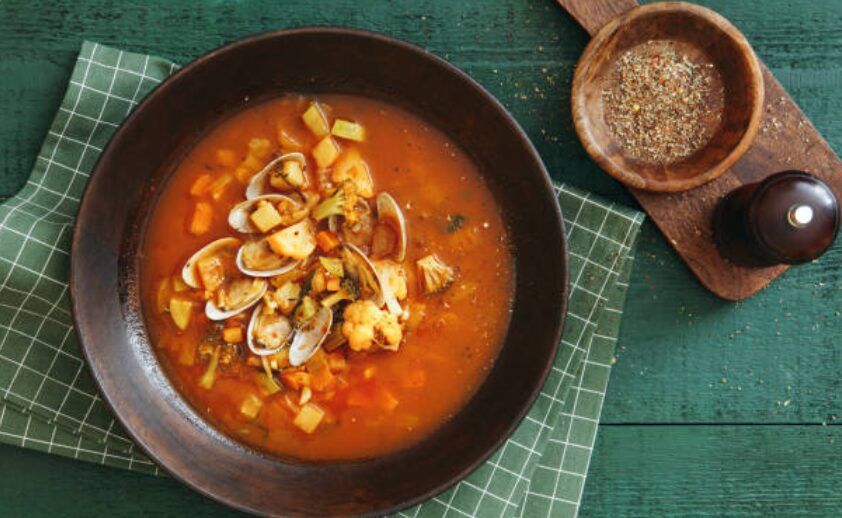Tadich Grill Cioppino Recipe

In the heart of San Francisco’s North Beach, a culinary institution has been serving up a taste of the city’s rich Italian-American heritage for over 100 years. Tadich Grill, California’s oldest continuously operating restaurant, has been delighting locals and visitors alike with its legendary Cioppino recipe since 1849. This iconic dish, born out of the city’s vibrant fishing community, has become a staple of San Francisco’s culinary identity. In this article, we’ll delve into the history of Tadich Grill and explore the secrets behind their beloved Cioppino recipe.
Also Read: Texas Roadhouse Grilled Shrimp Recipe in Just 10 Mins
Table of Contents
The History of Tadich Grill
Founded by Croatian immigrant John Tadich in 1849, Tadich Grill began as a humble coffee stand serving the city’s bustling waterfront. As the restaurant grew in popularity, Tadich expanded his menu to cater to the tastes of the local fishing community, incorporating fresh seafood into his dishes. In the early 1900s, Tadich’s son, Michael, took the reins and introduced Cioppino to the menu. This hearty, flavorful stew quickly became a favorite among the city’s fishermen and soon, the restaurant’s signature dish.

The Tadich Grill Cioppino Recipe
So, what makes Tadich Grill’s Cioppino recipe so special? The answer lies in the harmonious balance of flavors and the freshest ingredients, carefully selected to reflect the best of San Francisco’s seafood bounty. Here’s a breakdown of the recipe
The Challenge of Tadich Grill Cioppino Recipe
The Tadich Grill Cioppino recipe presents a culinary challenge due to its intricate balance of flavors and textures, requiring precise timing and technique to execute. With a medley of fresh seafood, including delicate fish and shellfish, the dish demands gentle handling to prevent overcooking. The broth, a masterful blend of tomatoes, white wine, and fish stock, must be patiently simmered to develop depth and richness.

Moreover, the recipe’s success hinges on the quality and freshness of its ingredients, making sourcing the best seafood and produce a constant challenge. Finally, the dish’s iconic status and loyal following raise the bar for consistency and authenticity, pressuring chefs to replicate the legendary flavors and presentation that have made Tadich Grill’s Cioppino a San Francisco institution.

Tadich Grill Cioppino Recipe
Description
Tadich Grill’s Cioppino Recipe is a hearty, flavorful San Francisco-style seafood stew that serves 4-6 people. This iconic dish is prepared in 30 minutes, cooked in 45 minutes, and rested for 10 minutes, totaling 1 hour 25 minutes. With approximately 450-550 calories per serving, Cioppino is a satisfying and savory meal that combines fresh seafood, including fish, shellfish, and mollusks, with aromatics, tomatoes, white wine, fish broth, and spices. This beloved recipe is a testament to the rich culinary heritage of San Francisco’s Italian-American community, offering a delicious and memorable dining experience.
Ingredients
Instructions
- Seafood selection: Tadich Grill’s chefs carefully choose the freshest seafood available, often sourced from local fishermen.
- Aromatics: Onions, garlic, and bell peppers are sautéed in olive oil to create a flavorful base.
- Tomatoes and wine: Fresh tomatoes and white wine are added to the pot, creating a rich, tangy broth.
- Seafood addition: The seafood is carefully added to the pot, allowing each piece to cook to perfection.
- Flavor enhancement: Fish broth, spices, and herbs are added to enhance the stew’s depth and aroma.
- Finishing touches: Fresh parsley and lemon are added just before serving, adding a bright, citrusy note.
Notes
- This recipe is a faithful reproduction of Tadich Grill’s iconic Cioppino dish, a San Francisco institution since 1849. To ensure authenticity and flavor, use only the freshest seafood and ingredients, and follow the cooking instructions carefully. Traditionally, Cioppino is served with crusty sourdough bread for sopping up the rich broth. For a truly immersive experience, pair with a glass of white wine and enjoy in the company of good friends and family, just as the Tadich Grill has been doing for over 170 years. Buon appetito!
Calories Per Serving
Approximately 450-550 calories
- Protein: 35-40g (from seafood and fish)
- Fat: 20-25g (from olive oil, fish, and seafood)
- Carbohydrates: 20-25g (from tomatoes, white wine, and bread)
- Fiber: 4-5g (from vegetables and bread)
- Sodium: 400-500mg (from seafood, tomatoes, and broth)
- Cholesterol: 60-70mg (from seafood and fish)
Note: This is an estimate and actual calorie count may vary based on specific ingredients, portion sizes, and cooking methods used.
Frequently Asked Questions
What type of fish is traditionally used in Cioppino?
The traditional fish used in Cioppino is a firm white fish, such as halibut or snapper.
Can I use frozen seafood in Cioppino?
While fresh seafood is preferred, frozen seafood can be used as a substitute. Just be sure to thaw and rinse it before using.
What is the best way to serve Cioppino?
Cioppino is traditionally served with crusty sourdough bread for sopping up the broth.
Can I make Cioppino ahead of time?
Yes, Cioppino can be made ahead of time and refrigerated or frozen for later use. Just be sure to reheat it gently to preserve the flavors.
Is Cioppino spicy?
Cioppino has a mild flavor profile, but you can add red pepper flakes or hot sauce to give it a spicy kick if desired.
Can I customize the seafood in Cioppino?
Absolutely! Feel free to add or substitute your favorite seafood, such as shrimp, scallops, or mussels, to make the dish your own.
Conclusion
Tadich Grill’s Cioppino recipe is a testament to the power of tradition, community, and fresh, locally sourced ingredients. This beloved dish has been delighting San Franciscans and visitors for generations, and its legacy continues to inspire new generations of chefs and food enthusiasts. Whether you’re a seafood lover, a history buff, or simply a curious foodie, Tadich Grill’s Cioppino recipe is a must-try experience that will leave you with a deeper appreciation for the rich culinary heritage of San Francisco.
